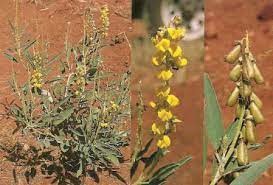Walkabout disease

Caption: The Crotolaria plant which causes Walkabout disease in horses.
In February and March 2021, a number of horses in the Katherine region of the Northern Territory (NT) were diagnosed with Walkabout disease.
This is also known as Crotolaria poisoning and as Kimberley horse disease. It affects horses that graze on plants of the genus Crotalaria. These plants are commonly known as rattlepods and Gambia peas.
The disease usually occurs when horses graze small amounts of the plant over a number of years with a slow progression of clinical signs in chronic cases. Acute cases are rare but can occur, with sudden onset of clinical signs soon after a horse eats a large amount of the plant.
The toxins in the Crotolaria plants are known as pyrrolizidine alkaloids and cause progressive liver damage. Once the toxicity affects more than 70% of the liver, the organ is unable to perform normal, vital functions.
Walkabout disease is a common cause of mortality in horses in the NT.
Horses with Walkabout disease may have any of the following signs:
- anorexia (off feed)
- weight loss
- jaundice (gums and the whites of eyes have a yellow or peach-coloured tinge)
- horses become dull and depressed
- muscle tremors, especially of the head and neck
- frequent yawning
- head pressing into a tree or a stable wall
- urine may be copper coloured or red
- attacks of frenzy and violent, uncontrollable galloping
- difficult swallowing, horses may stop eating halfway through a mouthful of hay or grass
- horses often stand with their heads hanging down
- affected horses appear to be blind and may aimlessly wander, walking in circles or bumping into objects and head-pressing (hence the name ‘walkabout disease’)
- dragging of the hind legs, causing the hooves to have worn tips.
Treatment and prevention
Liver damage caused by pyrrolizidine alkaloids is not reversible. Anecdotal evidence suggests that horses may survive many years with reduced liver function, but may struggle to gain or maintain weight. Consult your veterinarian to develop a monitoring and treatment plan for managing long-term liver failure in affected horses. Once a horse develops signs of Walkabout disease, the prognosis is very poor.
Preventing horses from accessing Crotolaria plants is the best prevention. During periods of feed shortage, remove horses from paddocks that contain Crotalaria plants and feed good quality hay or a combination of hay and grain. If possible, remove all Crotalaria species from horse paddocks mechanically or by using appropriate herbicides.
More information
You can find images and information to identify Top End Crotolaria species on the NT Herbarium website.
An Agnote is available on Walkabout disease PDF (339.6 KB).
